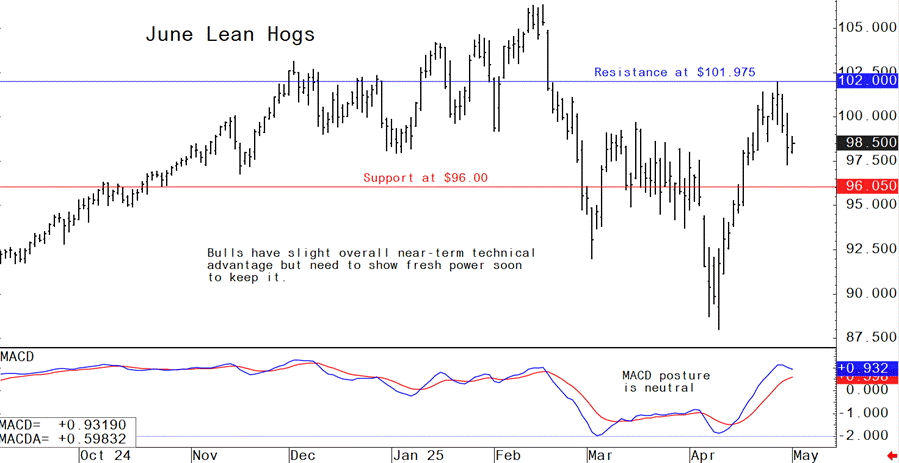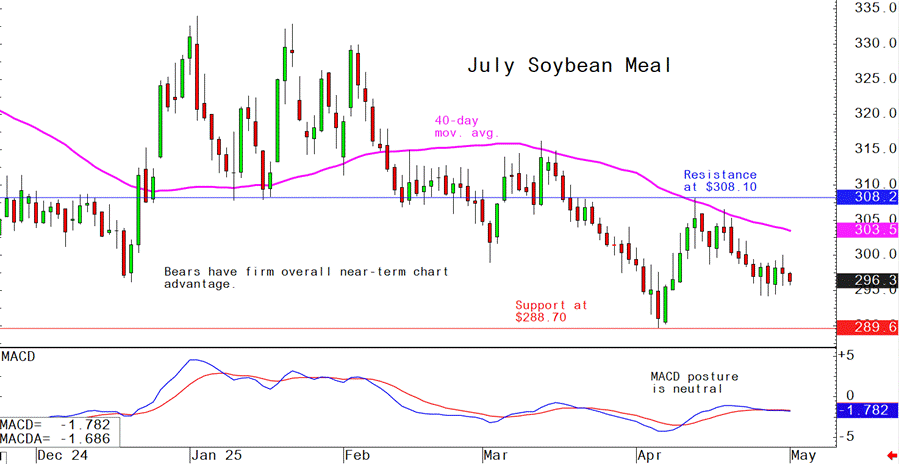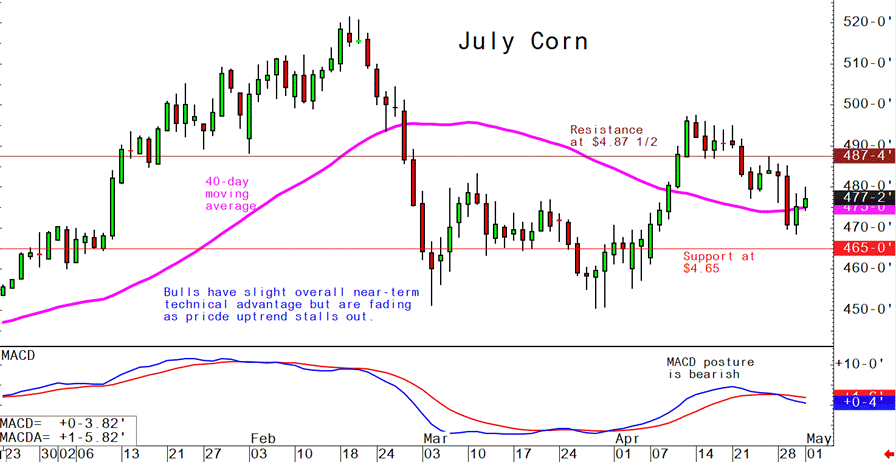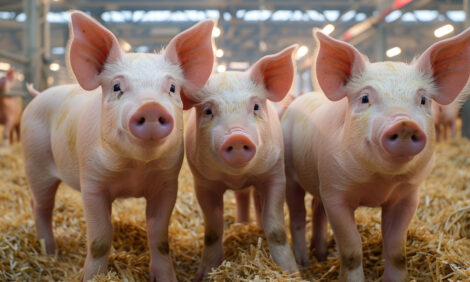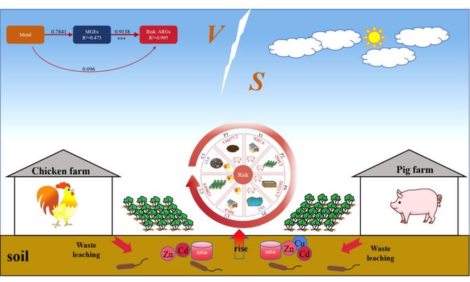



Pig outlook: Lean hog futures bulls fading late this week
Livestock analyst Jim Wyckoff reports on global pig newsJune lean hog futures Wednesday dropped to a two-week low on heavy profit-taking pressure, to begin to suggest that a near-term market top is in place. Remember, however, that in past months the lean hog futures bulls have shown keen resilience on price setbacks. Hog futures late this week saw traders narrow futures premiums to the cash index. The latest CME lean hog index is up 47 cents to $89.25 as of April 29. The narrowing premiums in the hog futures market suggest traders' anticipation of slowing cash hog market gains in the coming weeks.
Latest USDA and other news regarding the global pork industry
Weekly US pork export sales
Pork: Net sales of 34,500 MT for 2025 were up noticeably from the previous week and up 34 percent from the prior 4-week average. Increases were primarily for Mexico (20,000 MT, including decreases of 100 MT), Japan (3,500 MT, including decreases of 300 MT), South Korea (2,900 MT, including decreases of 100 MT), Australia (2,500 MT), and Colombia (1,100 MT, including decreases of 100 MT). Exports of 25,800 MT were down 5 percent from the previous week and 15 percent from the prior 4-week average. The destinations were primarily to Mexico (10,500 MT), South Korea (4,700 MT), Japan (4,400 MT), Colombia (1,400 MT), and Canada (900 MT).
Smithfield cuts China pork exports amid soaring tariffs
Smithfield Foods, the largest U.S. pork processor, has declared China an unviable market for its pork exports after Beijing’s retaliatory tariffs pushed the effective duty rate on U.S. pork to 172%. This steep tariff hike, a response to U.S. trade measures, has rendered American pork exports uncompetitive in the world’s largest pork-consuming nation.
China previously accounted for about 3% of Smithfield’s sales, primarily through the export of variety meats such as pig stomachs, hearts, and heads-products with little demand among U.S. consumers. The company’s CEO, Shane Smith, stated, “With China effectively off the table, we had to adapt our business model significantly,” emphasizing a strategic pivot to alternative international markets.
Despite this setback, Smithfield reported a robust first quarter for 2025, with sales rising 9.5% to $3.77 billion, surpassing analyst expectations. The company now exports to over 30 countries, and executives are optimistic that demand for pork products originally destined for China will be met in these other markets.
Smithfield’s leadership acknowledged that the loss of the Chinese market is significant but maintain that the company is well-positioned to redirect its exports and focus on higher-margin products domestically and abroad. However, they also cautioned that increased domestic supply due to lost exports could pressure U.S. pork prices.
The trade tensions, which began with U.S. tariff hikes on Chinese goods, have forced Smithfield to streamline operations, including job reductions, as it navigates higher input costs and shifting consumer demand. The company remains committed to its diversified export strategy and core brands as it adapts to the evolving global trade landscape.
China’s plan to slash grain and soymeal use in livestock feed
China is undertaking a significant transformation in its livestock feed sector, aiming to reduce reliance on grain and soybean meal by 2030 as part of a broader strategy to enhance food security, cut costs, and boost efficiency in animal agriculture.
Key targets and strategies
- Reduced grain and soybean meal use: By 2030, grain is expected to account for around 60% of total feed consumption in China, down from higher current levels, while soybean meal usage is targeted to drop to about 10%. This is a notable reduction, as soybean meal ratios in animal feed were 14.5% in 2022, with interim targets set below 13% by 2025.
- Lower feed consumption per animal product: The Ministry of Agriculture and Rural Affairs projects more than a 7% drop in feed consumption per kilogram of animal product in standardized large-scale farms by 2030 compared to 2023. This reflects a push for greater feed efficiency and resource utilization.
- Expansion of non-grain feed resources: China plans to expand the use of alternative protein sources such as microbial protein, food waste, insect protein, and animal-based protein, aiming for a production capacity exceeding 10 million metric tons by 2030. Pilot projects are already underway in several cities to use food waste and animal carcasses as feed inputs.
Implementation measures
- Feed formulation innovations: The government is promoting low-protein diet technologies and the use of synthetic amino acids, which can reduce soybean meal and grain use by up to 20 million tons without increasing feed costs. Feed makers are also encouraged to substitute soymeal with rapeseed, sunflower seed, and other protein sources.
- Utilization of domestic protein resources: There is a focus on maximizing domestic protein sources, including underutilized animal-derived and unconventional protein materials, which could replace up to 14 million tons of soybean meal and grains.
- Grass instead of grain: For ruminant livestock, China is promoting the cultivation of high-quality forage crops and the use of marginal lands for grass production, aiming to reduce feed grain use by over 14 million tons.
Broader livestock sector reforms
- Large-scale, efficient farming: China is accelerating the shift from small-scale, traditional farms to large-scale, standardized operations. By 2030, large-scale farms are projected to account for 75% of pig production, with widespread adoption of digital and precision farming technologies to further improve feed efficiency and environmental sustainability.
- Integrated and cooperative models: The ministry is supporting integrated dairy projects, efficient poultry systems, and the development of family farms and cooperatives to modernize production and optimize resource use.
Implications
- Reduced soybean imports: Lower soymeal use is projected to decrease China’s soybean imports from about 95 million tonnes currently to as low as 82–84 million tonnes by 2025–2030, reducing dependency on major exporters like the U.S. and Brazil.
- Food security and sustainability: These reforms are designed to build a more resilient supply chain, improve domestic food security, and reduce the environmental footprint of China’s livestock industry.
USDA April Outlook: 2025 food price increases accelerate, stay above 20-year average
USDA’s April forecast projects higher food price inflation in 2025 compared to March estimates, with all food prices expected to rise 3.5%, grocery prices 3.2%, and restaurant prices 3.8% — all above the 20-year historical average. While still well below the sharp increases of 2022, the outlook signals continued pressure on consumers.
Key updates include:
- Beef prices forecast to rise 6.3%, up from 5.2% expected in March, due to tight supplies and strong demand.
- Egg prices still volatile but now expected to rise 54.6% in 2025, slightly lower than the March forecast of 57.6%.
- Pork prices revised upward to a 1.8% increase, despite higher production forecasts.
- Fruit and vegetable prices are now expected to decline 0.3% in 2025, compared to a flat forecast in March.
- Other foods category inflation was sharply revised up to 1.8% from 0.2%, reflecting broader grocery pressures.
The report notably omits discussion of new tariffs, suggesting current 10% tariffs have not broadly impacted food prices yet. However, potential tariff hikes on Mexican tomatoes later this year could alter the vegetable price outlook.
Of note: Despite forecast increases, the rate of food inflation remains well below the extraordinary surges seen in 2022 and 2023.
The next week’s likely high-low price trading ranges:
June lean hog futures--$95.00 to $101.975 and with a sideways-lower bias
July soybean meal futures--$289.70 to $308.10, and with a sideways bias
July corn futures--$4.65 to $4.90 and a sideways bias
Latest analytical daily charts lean hog, soybean meal and corn futures
